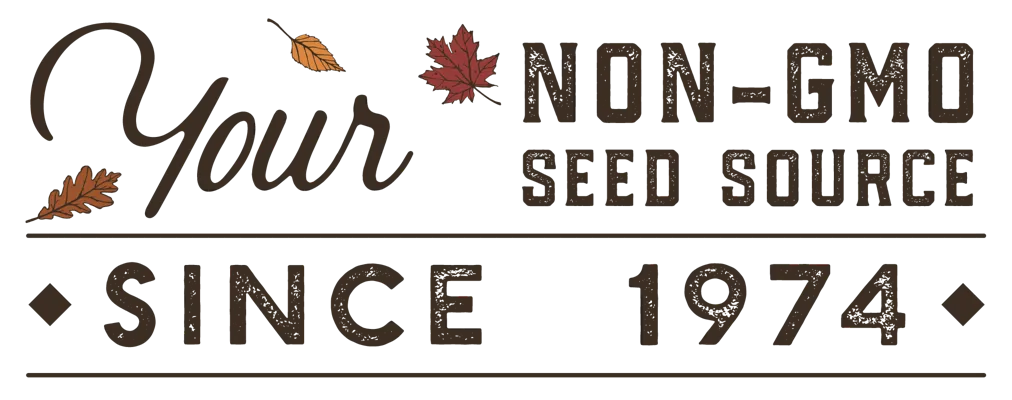Download Free Vegetable Growing Guide PDF
Growing Charentais Melon in the Vegetable Garden
Charentais melon seeds should be sown at a depth of 0.5 inches. If you are directly sowing the seeds into your garden, waiting until all danger of frost has passed and the soil temperature has warmed to at least 70 F is essential. These melons prefer warm soil, so if you live in a cooler climate, you may want to start the seeds indoors and transplant them after they’ve grown. If you start your seeds indoors, harden off the seedlings before transplanting them into the garden. If growing in containers, use one that can hold at least 5 gallons of soil.
For direct sowing, space the seeds about 24 inches apart in rows spaced 6 feet apart, as the vines will need plenty of room to spread. You can also opt for hill planting, which involves sowing 3-4 seeds per hill, spaced about 3 feet apart, with 5-6 feet between each hill. Once the seedlings have emerged and are a few inches tall, thin them out to the strongest seedling per hill.
Charentais melons are heavy feeders and require rich, well-drained soil. Before planting, amend the soil with plenty of organic matter, such as compost or well-rotted manure. When the plants start to vine, give them a balanced fertilizer like 10-10-10 to promote healthy growth. Avoid excess nitrogen, as this can result in lush foliage but fewer fruits.
Keep the soil consistently moist but not waterlogged, aiming for about 1 to 2 inches of water per week. Use a drip irrigation system or water at the base of the plant to avoid wetting the foliage, which can lead to fungal diseases. Be careful not to overwater once the fruits start maturing. If grown vertically, training the vines along trellises or supports can improve air circulation and make harvesting easier. In areas with few pollinators, you may need to hand-pollinate your melon flowers to ensure fruit set.
Harvesting Charentais Melon
You’ll know the melons are ready when they emit a strong, sweet fragrance, the rind color changes from green to golden-yellow, and the fruit easily slips off the vine with a gentle tug. To harvest, simply twist or snip the melon from the vine. Avoid pulling or yanking the fruit off. Handle with care.
About Charentais Melon Garden Seeds
An heirloom variety dating back to France in the 1920s, this Charentais melon was bred in the Poitou-Charentes region (hence the name). Originally developed for the French market, this melon was bred for its exceptional flavor and small size, which makes it perfect for individual servings.
It quickly gained a reputation as a gourmet fruit, beloved for its intensely sweet, aromatic flesh and smooth texture. It’s often associated with the town of Cavaillon, where it is celebrated as a local delicacy.
Mother Earth News says, "Among many delicious melons that are too fragile to ship, the French cantaloupes are at the top of my list. Perfectly sized for a half-melon serving, the French Charentais types have thick, firm, orange flesh and a small seed cavity."
In her book Melons for the Passionate Grower, Amy Goldman writes, “It is a refined cantaloupe… free of the blemishes and warts of its ancestors."
Tips From Our Gardeners
"Charentais melons are best enjoyed soon after harvest. They do not store, ship, or transport well. These melons are ideal for home gardeners who want to enjoy a piece of French culinary history in their backyard."
 |
- Lara Wadsworth, True Leaf Market Writer
|
Other Resources
Non-GMO Charentais Melon seeds are available for Fast Free Shipping on qualifying orders.
ATTRIBUTES
Basic Info
| Latin Name: |
Cucumis melo var. inodorus
|
| Melon Type: |
Other - There are many categories of melons and anything not included in one of the named categories here are included in 'other'. These include but aren't limited to Galia, Canary, Charentais, Winter, Piel de Sapo, Christmas melons, etc. |
| Charentais Melon Color: |
Yellow skin with green striped and orange light flesh. |
| Charentais Melon Flavor: |
Intensely sweet, succulent, floral, and aromatic |
Growing Info
| Hardiness Zone: |
4, 5, 6, 7, 8, 9, 10, 11 Annual Crop: Not Intended to Overwinter |
| Days to Maturity: |
90 |
| Days to Germination: |
5-10 |
| Seeding Depth: |
0.5-1 inch |
| Plant Spacing: |
24 inches in row or 2-3 plants per hill. |
| Row Spacing: |
6 Feet |
| Plant Height: |
12-15 inches |
| Growth Habit: |
Sprawled, Trailing Vine |
| Soil Preference: |
Melons prefer warm, well-draining but moist, nutrient-rich, loamy to sandy loam soil with a pH of 6.5 to 7.5. |
| Temperature Preference: |
Warmer (70-90 F). |
| Light Preference: |
Full Sun |
Other
| Direct Sow: |
Yes, direct sow 1-2 weeks after your last frost date. |
| Start Indoors: |
Yes. Melons may be started indoors 2-4 weeks before your last spring frost date. Wait to transplant them outdoors until at least 1 week after your last frost date, as melons grow best with warm soil. Avoid leaving them in seed starting containers for long as melons are sensitive to transplanting. Harden off to reduce the effects of transplant shock. |
| Melon Pollination: |
Melons require insects, such as bees, for successful pollination. As monoecious plants they produce separate male and female flowers on the same plant. This means that not every flower will develop into fruit. We recommend growing an assortment of flowers near or throughout your garden to attract pollinators. |
| Plant Spread: |
36-48 inches |
| Plant Width: |
36-48 inches |
| Growth Speed: |
Mid - Ready for harvest around 80-95 days. |
| Deer Resistant: |
No |
| Germination Temperature: |
70-95 F |
| Pests and Diseases: |
Generally, melons are commonly susceptible to pest damage by aphids, cucumber beetles, squash bugs, cutworms, white flies, and melon worms. Look for signs of chewing, curling leaves, eggs on the undersides of leaves, and leaf discoloration. Melons are also susceptible to Powdery Mildew, Downy Mildew, and Fusarium Wilt, Anthracnose, and Bacterial Wilt. Maintain a regular watering schedule that avoids overly saturated soil. The roots need adequate time to air out between watering. This will also help prevent common fungal and bacterial diseases from developing. Good air circulation and applying water to the ground rather than the leaves will help maintain healthy bean plant growth. |
| Garden Size: |
Containers, Greenhouse, Garden Plot, Raised Bed |
| Melon Use: |
Ideal for fresh consumption, fruit salads, desserts. and pairing with cheeses and sweet wines. |
| Climate Tolerance: |
Heat |



















